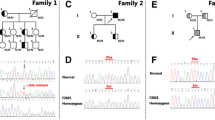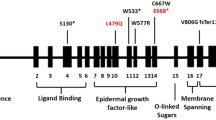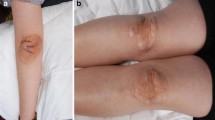Abstract
The majority of patients with the autosomal dominant disorder familial hypercholesterolemia (FH) carry novel mutations in the low density lipoprotein receptor (LDLR) that is involved in cholesterol regulation. In different populations the spectrum of mutations identified is quite different and to date there have been only a few reports of the spectrum of mutations in FH patients from Pakistan. In order to identify the causative LDLR variants the gene was sequenced in a Pakistani FH family, while high resolution melting analysis followed by sequencing was performed in a panel of 27 unrelated sporadic hypercholesterolemia patients. In the family a novel missense variant (c.1916T > G, p.(V639G)) in exon 13 of LDLR was identified in the proband. The segregation of the identified nucleotide change in the family and carrier status screening in a group of 100 healthy subjects was done using restriction fragment length polymorphism analysis. All affected members of the FH family carried the variant and none of the non-affected members nor any of the healthy subjects. In one of the sporadic cases, two sequence changes were detected in exon 9, one of these was a recurrent missense variant (c.1211C > T; p.T404I), while the other was a novel substitution mutation (c.1214 A > C; N405T). In order to define the allelic status of this double heterozygous individual, PCR amplified fragments were cloned and sequenced, which identified that both changes occurred on the same allele. In silico tools (PolyPhen and SIFT) were used to predict the effect of the variants on the protein structure, which predicted both of these variants to have deleterious effect. These findings support the view that there will be a novel spectrum of mutations causing FH in patients with hypercholesterolaemia from Pakistan.




Similar content being viewed by others
References
Rader DJ, Cohen J, Hobbs HH (2003) Monogenic hypercholesterolemia: new insights in pathogenesis and treatment. J Clin Invest 111:1795–1803
Zech LA Jr, Hoeg JM (2008) Correlating corneal arcus with atherosclerosis in familial hypercholesterolemia. Lipids Health Dis 7:7
Garg A, Simha V (2007) Update: update on dyslipidemia. J Clin Endocrinol Metab 92:1581–1589
Marques-Pinheiro A, Marduel M, Rabes JP, Devillers M, Villéger L, Allard D, Weissenbach J, Guerin M, Zair Y, Erlich D, Junien C, Munnich A, Krempf M, Abifadel M, Jaïs JP; French Research Network on ADH, Boileau C, Varret M (2010) A fourth locus for autosomal dominant hypercholesterolemia maps at 16q22.1. Eur J Hum Genet 18:1236–1242
Ajmal M, Ahmed W, Sadeque A, Ali SH, Bokhari SH, Ahmed N, Qamar R (2010) Identification of a recurrent insertion mutation in the LDLR gene in a Pakistani family with autosomal dominant hypercholesterolemia. Mol Biol Rep 37:3869–3875
Ajmal M, Ahmed W, Akhter N, Sadeque A, Khalid A, Ali SHB, Ahmed N, Azam M, Qamar R (2011) The first report of a pathogenic nonsense triple nucleotide polymorphism in a gene. Genet Test Mol Biomarkers 15:601–606
Marks D, Thorogood M, Neil HA, Humphries SE (2003) A review on the diagnosis, natural history, and treatment of familial hypercholesterolemia. Atherosclerosis 168:1–14
Williams RR, Hunt SC, Schumacher MC, Hegele RA, Leppert MF, Ludwig EH, Hopkins PN (1993) Diagnosing heterozygous familial hypercholesterolemia using new practical criteria validated by molecular genetics. Am J Cardiol 72:171–176
Whittall RA, Scartezini M, Li K, Hubbart C, Reiner Z, Abraha A, Neil HA, Dedoussis G, Humphries SE (2010) Development of a high-resolution melting method for mutation detection in familial hypercholesterolaemia patients. Ann Clin Biochem 47:44–55
Ramensky V, Bork P, Sunyaev S (2002) Human non-synonymous SNPs: server and survey. Nucleic Acids Res 30:3894–3900
Venselaar H, Beek TAH, Kuipers RKP, Hekkelman ML, Vriend G (2010) Protein structure analysis of mutations causing inheritable diseases. An e-science approach with life scientist friendly interfaces. BMC Bioinformatics 11:548
Austin MA, Hutter CM, Zimmern RL, Humphries SE (2004) Genetic causes of monogenic heterozygous familial hypercholesterolemia: a HuGE prevalence review. Am J Epidemiol 160:407–420
Snozek CL, Lagerstedt SA, Khoo TK, Rubenfire M, Isley WL, Train LJ, Baudhuin LM (2009) LDLR promoter variant and exon 14 mutation on the same chromosome are associated with an unusually severe FH phenotype and treatment resistance. Eur J Hum Gen 17:85–90
Goldstein JL, Brown MS, Anderson RG, Russell DW, Schneider WJ (1985) Receptor-mediated endocytosis: concepts emerging from the LDL receptor system. Annu Rev Cell Biol 1:1–39
Jeon H, Meng W, Takagi J, Eck MJ, Springer TA, Blacklow SC (2001) Implications for familial hypercholesterolemia from the structure of the LDL receptor YWTD-EGF domain pair. Nat Struct Biol 8:499–504
Lusis AJ, Fogelman AM, Fonarow GC (2004) Genetic basis of atherosclerosis: part I new genes and pathways. Circulation 110:1868–1873
Springer TA (1998) An extracellular b-propeller module predicted in lipoprotein and scavenger receptors, tyrosine kinases, epidermal growth factor precursor, and extracellular matrix components. J Mol Biol 283:837–862
Fouchier SW, Kastelein JJ, Defesche JC (2005) Update of the molecular basis of familial hypercholesterolemia in The Netherlands. Hum Mutat 26:550–556
Nauck MS, Koster W, Dorfer K, Eckes J, Scharnagl H, Gierens H, Nissen H, Nauck MA, Wieland H, Marz W (2001) Identification of recurrent and novel mutations in the LDL receptor gene in German patients with familial hypercholesterolemia. Hum Mutat 18:165–166
Leigh SEA, Foster AH, Whittall RA, Hubbart CS, Humphries SE (2008) Update and analysis of the University College London low density lipoprotein receptor familial hypercholesterolemia database. Ann Hum Genet 72:485–498
Bunn CF, Lintott CJ, Scott RS, George PM (2002) Comparison of SSCP and DHPLC for the detection of LDLR mutations in a New Zealand cohort. Hum Mutat 19:311
Acknowledgments
This work was financially supported by grant No 934 from the Higher Education Commission of Pakistan, awarded to RQ. Part of this work was supported by Shifa College of Medicine through a core grant to RQ. WA was supported by an IRSIP grant from HEC for his studies at UCL. We would like to thank the FH families and healthy individuals for donating their blood. SEH, RW and WP are supported by the British Heart Foundation (RG008/08).
Author information
Authors and Affiliations
Corresponding author
Rights and permissions
About this article
Cite this article
Ahmed, W., Ajmal, M., Sadeque, A. et al. Novel and recurrent LDLR gene mutations in Pakistani hypercholesterolemia patients. Mol Biol Rep 39, 7365–7372 (2012). https://doi.org/10.1007/s11033-012-1568-1
Received:
Accepted:
Published:
Issue Date:
DOI: https://doi.org/10.1007/s11033-012-1568-1




